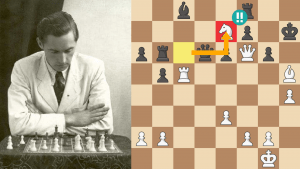
What Does The Position Need?
The puzzles in this article are a bit advanced, but don’t let that spook you. In general, these puzzles are about verbal recognition of what is going on. These kinds of puzzles help a player look beyond the usual mentality of “I go there, and he goes there." Instead, these puzzles will take you into the deep waters of the position’s needs.
Remember! You should not look for moves if you don't know what the position needs.
Puzzle One — White To Move
Black is a solid pawn up, and his pieces are well placed. All this makes it seem that White is doomed. Indeed, in the actual game, White went down hard.
To find a reasonable way to continue for White you need to notice, and label, the one thing that will give White counterplay.
Puzzle Two — Black To Move
Black has a very comfortable position. Moves like 11...Nbd7, 11...exd4 followed by ...Nb8-d7-c5, and 11...Qe7 are all excellent. Even 11...Bd7 (the move played in the game) is good since it develops and defends the a4-pawn. In that case, the b8-knight can move to a6 or c6. However, what about 11...Bg4, attacking the e2-knight and developing a piece? Is this a good idea, or is it silly? If it’s good, figure out why. If it’s dumb, also figure out why.
Puzzle Three — Black To Move
We have an interesting position. White has more space in the center and kingside, and White’s ahead in development. How would you assess the position? Also, are the moves 14...Nc6 and 14...exd4 any good?

Answer To Puzzle One
Question:
Black is a solid pawn up, and his pieces are well placed. All this makes it seem that White is doomed. Indeed, in the actual game, White went down hard.
To find a reasonable way to continue for White you need to notice, and label, the one thing that will give White counterplay.
Answer:
Black threatens to conquer the board with ...Re5 followed by ...d6-d5. However, by noticing the one weakness Black has (an airy king), White can do everything possible to take advantage of it.
Answer To Puzzle Two
Question:
Black has a very comfortable position. Moves like 11...Nbd7, 11...exd4 followed by ...Nb8-d7-c5, and 11...Qe7 are all excellent. Even 11...Bd7 (the move played in the game) is good since it develops and defends the a4-pawn. In that case, the b8-knight can move to a6 or c6. However, what about 11...Bg4, attacking the e2-knight and developing a piece? Is this a good idea, or is it silly? If it’s good, figure out why. If it’s dumb, also figure out why.
Answer:
This is an excellent move since the e2-knight can’t move due to 12...exd4. However, many would think that 11...Bg4 is silly since White can kick the bishop away by 12.f3. However, that’s simply not the case. In fact, if Black wants to place his bishop on d7, it’s better to start out with this move first. Why? After 12.f3 Bd7, White’s bishop is blocked by its f3- and e4-pawns. Without f2-f3, the g2-bishop can leap into action if Black ever (somehow) plays ...d6-d5 or ...f7-f5. Now though, the only way for the bishop to have any future life on the h1-a8 diagonal is to play f3-f4, which weakens White’s center and leaves e4 and g4 vulnerable.

No passing for you, Mr. Light-Square Bishop!
One other thumbs up for 11...Bg4 12.f3 Bd7 is that the dark squares along the g1-a7 have been compromised. Black’s queen might end up on that diagonal (via ...Qd8-b8-a7 or ...c6 followed by ...Qb6) and cause White some problems.
These are little things, but in high-class chess, little things often add up.
Answer To Puzzle Three
Question:
We have an interesting position. White has more space in the center and kingside, and White’s ahead in development. How would you assess the position? Also, are the moves 14...Nc6 and 14...exd4 any good?
Answer:
Though White has more development and space, White’s pieces aren’t on particularly good squares, and White’s space advantage comes with various weaknesses. The dark-squares along the g1-a7 diagonal are vulnerable, and the f4-, g5-, and h4-squares are also getting close to “hole” status. Due to these things, Black has the better position.
Though 14...Nc6 is perfectly playable, it allows White to close the center with 15.d5 Ne7. This is also very nice for Black, but it’s a bit harder to crack White’s egg due to the closure of the center. After 14...Nc6 15.d5 Ne7, the actual game went 16.Qd3 Ng6 17.Qe3 Qd8 18.Rfc1 b6 with an edge, but the game was eventually drawn.
An interesting question is whether or not 14...Nc6 15.d5 Ne7 16.c5 is a good way for White to get some play. How would you play this position?
Though Black got an advantage with 14...Nc6 15.d5 Ne7, better was:
For fun, let’s take a look at what could happen after 14...exd4 15.Nxd4 Nc6 16.Nf5:






